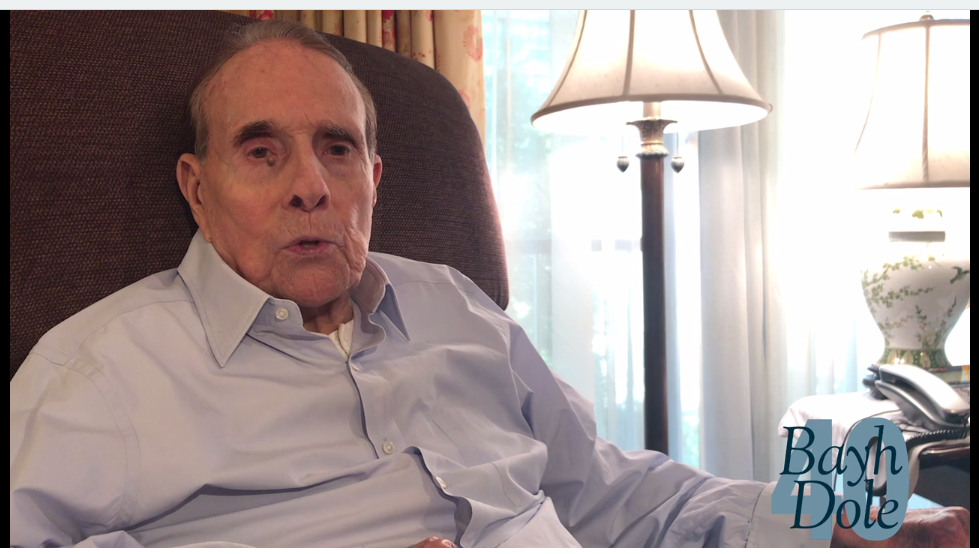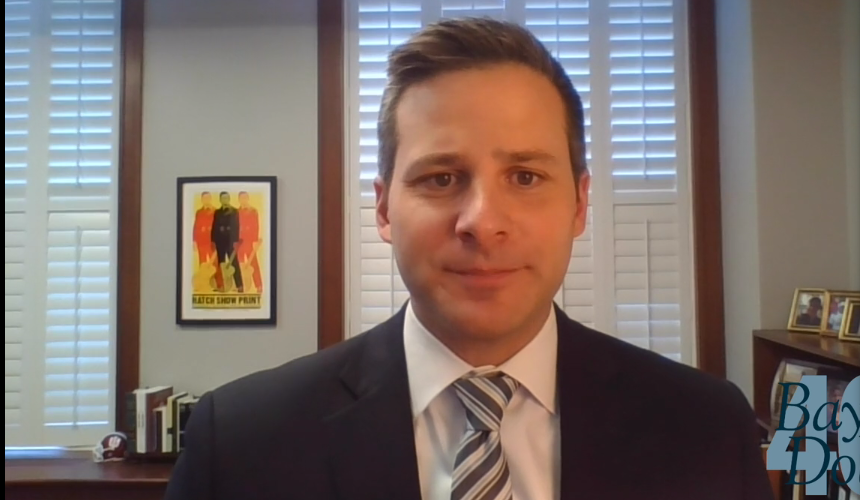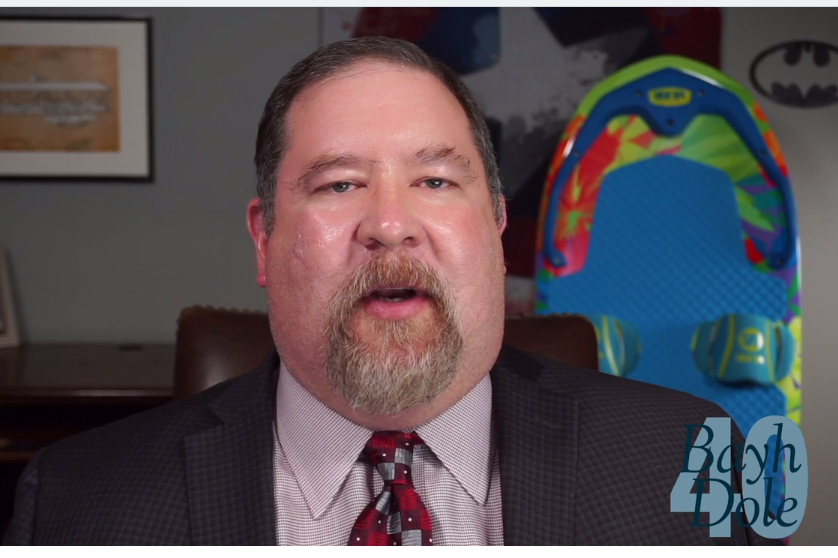“There is a misguided view that holds that patents are somehow not necessary and that inventors will invent and companies will spend millions or billions of dollars in research and development without the prospect of owning any rights in what is being developed. That fairly-tale fantasy is not real life, and it ignores human nature. ” – Gene Quinn

Senator Bob Dole
The Bayh-Dole 40 Coalition and IPWatchdog today jointly presented a video webinar commemorating the 40th anniversary of the Bayh-Dole Act— officially the “University and Small Business Patent Procedures Act”—which became law on December 12, 1980. The webinar was hosted by Joseph Allen, a regular IPWatchdog contributor and former Professional Staff Member on the U.S. Senate Judiciary Committee for former Senator Birch Bayh (D-IN). The event included remarks from Senator Bob Dole, who served as Republican Senator for Kansas from 1969-1996 and co-authored the Bayh-Dole Act; Senator Bayh’s son, Chris Bayh; Under Secretary of Commerce for Standards and Technology, Walter Copan; IPWatchdog Founder and CEO Gene Quinn; and many other speakers from across the political, technology transfer, university research, and legal spheres.

Chris Bayh
Chris Bayh said that the Bayh-Dole Act was one of the achievements his father treasured most “because of the impact it’s had and the cooperative legislative effort it took.” The Act had support from one side of the political spectrum to the other, and Bayh said that the lesson his father impressed upon him about the fight it took to get it passed was that “the work and determination of just a few people can make a huge difference in the lives of so many.”
Quinn recounted his interview with Birch Bayh in 2010, on the 30th anniversary of the Act, and explained why advocates for chipping or doing away with the Bayh-Dole Act are sorely misguided. Following is the transcript of Quinn’s remarks. You can view the full webinar below (see bottom of this page).
Hello, everyone. It is a pleasure to be here with you today to discuss the role of patents in the innovation ecosystem. As a patent attorney it probably comes as no surprise that I think patents are essential to bringing innovation into being.
Over the years, I have watched and listened as critics of the patent system argue for the United States to forfeit the future in favor of something that has never worked. Curtailing patent rights has never worked to produce more innovation anywhere it has been tried. Indeed, to the contrary, where patent rights are weak there is little innovation and no investment in research and development. Why? Because you cannot invest in what you do not own, it really is that simple.
We innately understand this simple truth about not being able to invest what you do not own. For those of you who are homeowners think back to the time when you were a renter. Did you invest in improvements for the property you were renting? Few, if any, renters invest in property they rent. When something breaks you expect the owner to fix the property because it isn’t yours. It just doesn’t make sense to invest in what you do not own.
 But what happens when no one can own the property? Well, that is the type of thing we experienced prior to the passage of Bayh-Dole and it isn’t pretty. The federal government was paying for basic research that would lead to patent innovations and the rules in place were so byzantine that it was virtually impossible to acquire those rights from the federal government by license that no one did, so the rights just sat there, not being exploited because no one could own the rights so no one could invest in what would be necessary to take that basic research and engage in the translational research and commercialization research necessary to make commercial products a reality.
But what happens when no one can own the property? Well, that is the type of thing we experienced prior to the passage of Bayh-Dole and it isn’t pretty. The federal government was paying for basic research that would lead to patent innovations and the rules in place were so byzantine that it was virtually impossible to acquire those rights from the federal government by license that no one did, so the rights just sat there, not being exploited because no one could own the rights so no one could invest in what would be necessary to take that basic research and engage in the translational research and commercialization research necessary to make commercial products a reality.
That was why Senator Birch Bayh took action when presented with the problem. In 2010, in anticipation of the 30th anniversary of Bayh-Dole, I had the opportunity to interview Senator Bayh at great length. He explained to me that it seemed logical that if the federal government had paid for the research the federal government should own the patent rights, but when he looked at the data and understood what was actually happening he realized the system wasn’t working and something drastic needed to change for America to gain the benefit of all the money the Congress was investing in basic research. He and Senator Dole, with the assistance of many others in the private sector, worked to create a system that would allow universities to own the patent rights to the inventions they created. They would be required to license them into the marketplace and small businesses would be given preferences. And the rest, as they say, is history. Bayh-Dole has been successful beyond anyone’s wildest dreams.
Still, every year there are those who seek to dismantle Bayh-Dole and return to a time when university innovations languished. Given pre-Bayh-Dole history, and the reality that a weak patent system has never lead to economic success anywhere, ever, those who seek to dismantle Bayh-Dole should carry a very heavy burden when seeking to persuade others that their path, which has been tried and failed, would somehow and for some reason work this time. They won’t be able to meet such a burden.
It would be an enormous mistake to chip away at Bayh-Dole, or do away with it all together, as is sometimes advocated. Patents foster innovation, lead to growth, incentivize investment and a create a more prosperous economy. But there is a misguided view that holds that patents are somehow not necessary and that inventors will invent and companies will spend millions, tens of millions, even hundreds of millions or billions of dollars in research and development without the prospect of owning any rights in what is being developed. That fairly-tale fantasy is not real life, and it ignores human nature. You simply cannot invest money to create if the minute it has been created it can be legally taken by others who did not have to spend those sunk costs to create. Those copycats will be able to undercut the creator who invested in the creation, and pretty soon there will be no creators and only copyists.
As logical as the need to own what you invest in is, many critics will still tell you that patents are bad because they block innovation, but that is a short-sighed view that fundamentally misunderstands the patent system.
The patent system has been intended from its very earliest days to create the very blocking scenario critics complain about. Patents are by specific design intended to give the patent owner an exclusive right to prevent others from making, using, selling and importing products (or services) covered by a U.S. patent. That is specifically why patents promote innovation rather than harm innovation, and it the point missed or more often completely ignored by critics.
The short of it is this: When an innovative person is blocked by a patent they design around. This is precisely why the Supreme Court has historically focused on preemption when determining issues of patent eligibility. If an idea as a whole is preempted then no patent can issue. If, on the other hand, there remain ways forward then it is incumbent upon the second comers to either find ways forward that do not infringe, or to simply stand clear of the rights granted the patentee altogether.
It has always been this rigid exclusive nature of patents that has caused innovation to move forward. As one area becomes saturated an entire new paradigm must be discovered, refined and perfected. It is those paradigm changing innovations that we as society want, but often when paradigm changing innovation does occur critics will start to ask if the innovation is too important to be patented. Too important to be patented? Invention of great importance is precisely the type of invention that the patent system wants to encourage and the type of invention that demands to be patented.
Taking risk is absolutely required in order to achieve innovation of a magnitude great enough to change the world, and it is precisely that type of innovation that is often the subject of the basic, early stage research that scientists and engineers at American Universities are hard at work trying to bring to bear. If we want disruptive innovation from big thinkers that will address the most challenging problems we face, we need an ecosystem that supports, encourages and nurtures risk-taking, including the investment of capital to bring innovations into being.
Assuming America wants paradigm-shifting, truly disruptive innovation we need to recognize the need to incentivize the risk-takers and those that provide the capital to those risk-takers who dare to challenge the status quo. This means policies, laws and rules that foster innovative activities up and down the ecosystem, from university researcher to university start-up to large multi-national corporation that will eventually bring the cure, treatment or vaccine to market.
In order to accomplish this, it all starts with patents, because you cannot invest in what you cannot own.
Thank you.

![[IPWatchdog Logo]](https://ipwatchdog.com/wp-content/themes/IPWatchdog%20-%202023/assets/images/temp/logo-small@2x.png)

![[Advertisement]](https://ipwatchdog.com/wp-content/uploads/2024/04/Artificial-Intelligence-2024-REPLAY-sidebar-700x500-corrected.jpg)
![[Advertisement]](https://ipwatchdog.com/wp-content/uploads/2024/04/Patent-Litigation-Masters-2024-sidebar-700x500-1.jpg)

![[Advertisement]](https://ipwatchdog.com/wp-content/uploads/2021/12/WEBINAR-336-x-280-px.png)
![[Advertisement]](https://ipwatchdog.com/wp-content/uploads/2021/12/2021-Patent-Practice-on-Demand-recorded-Feb-2021-336-x-280.jpg)
![[Advertisement]](https://ipwatchdog.com/wp-content/uploads/2021/12/Ad-4-The-Invent-Patent-System™.png)






Join the Discussion
No comments yet.